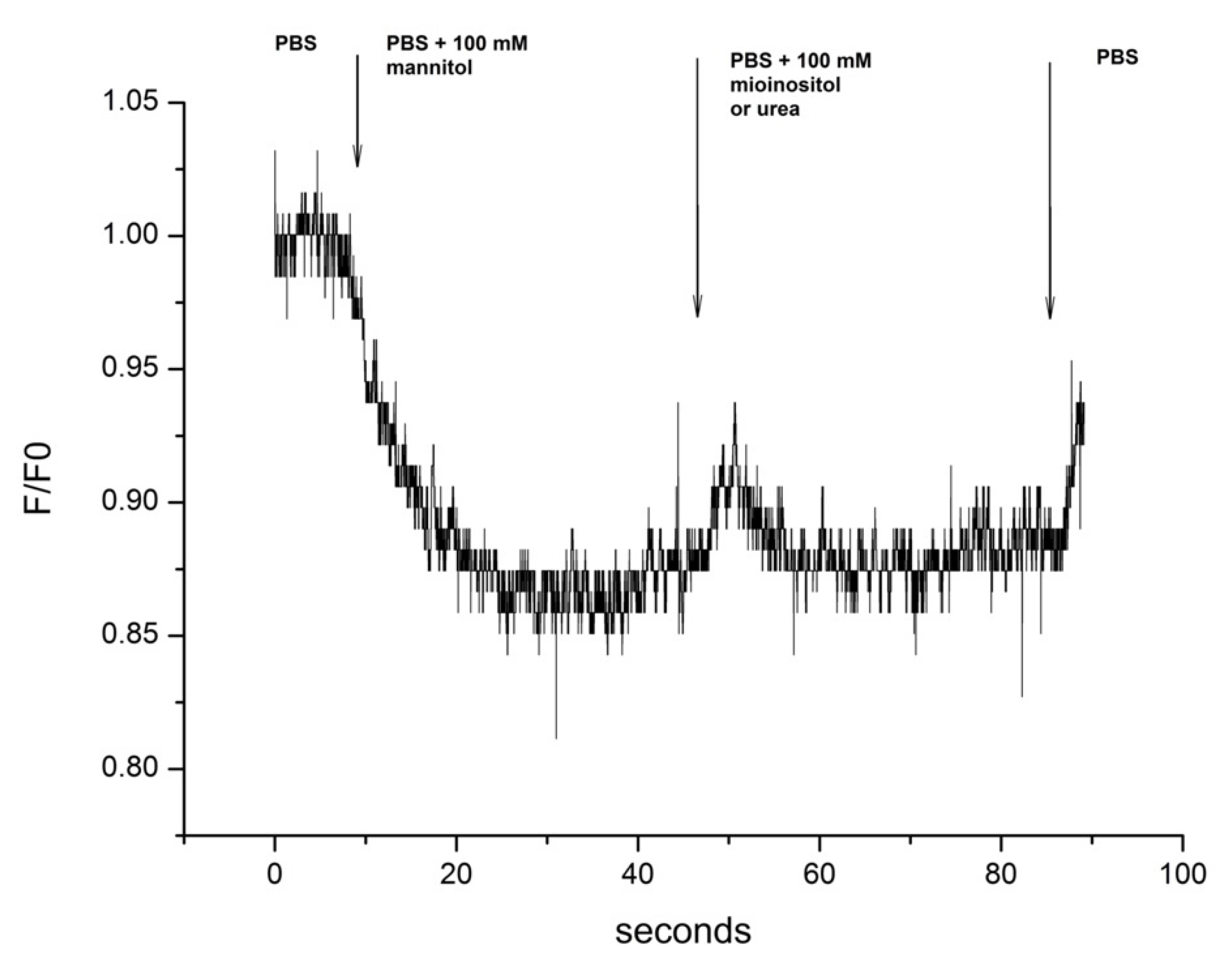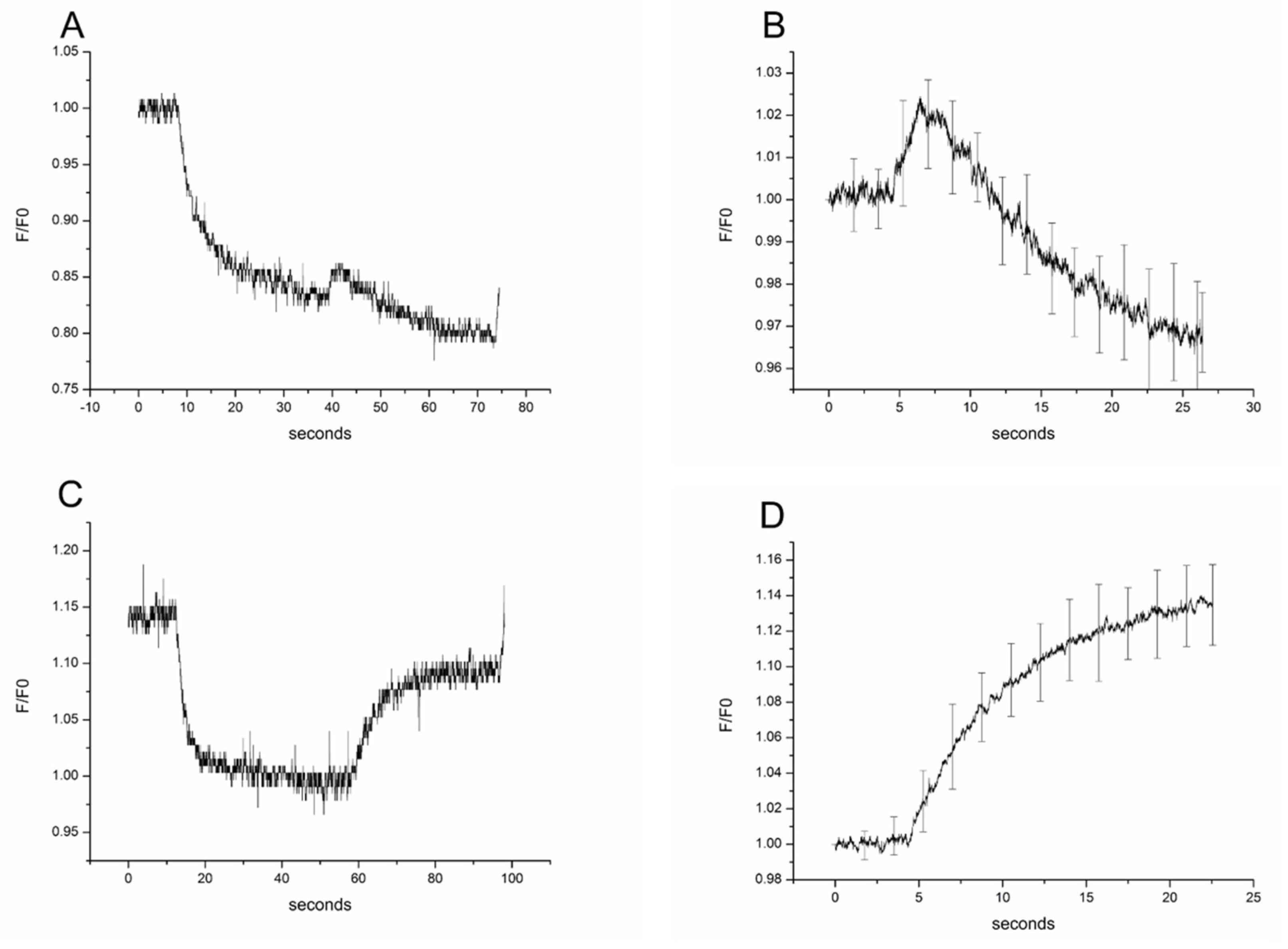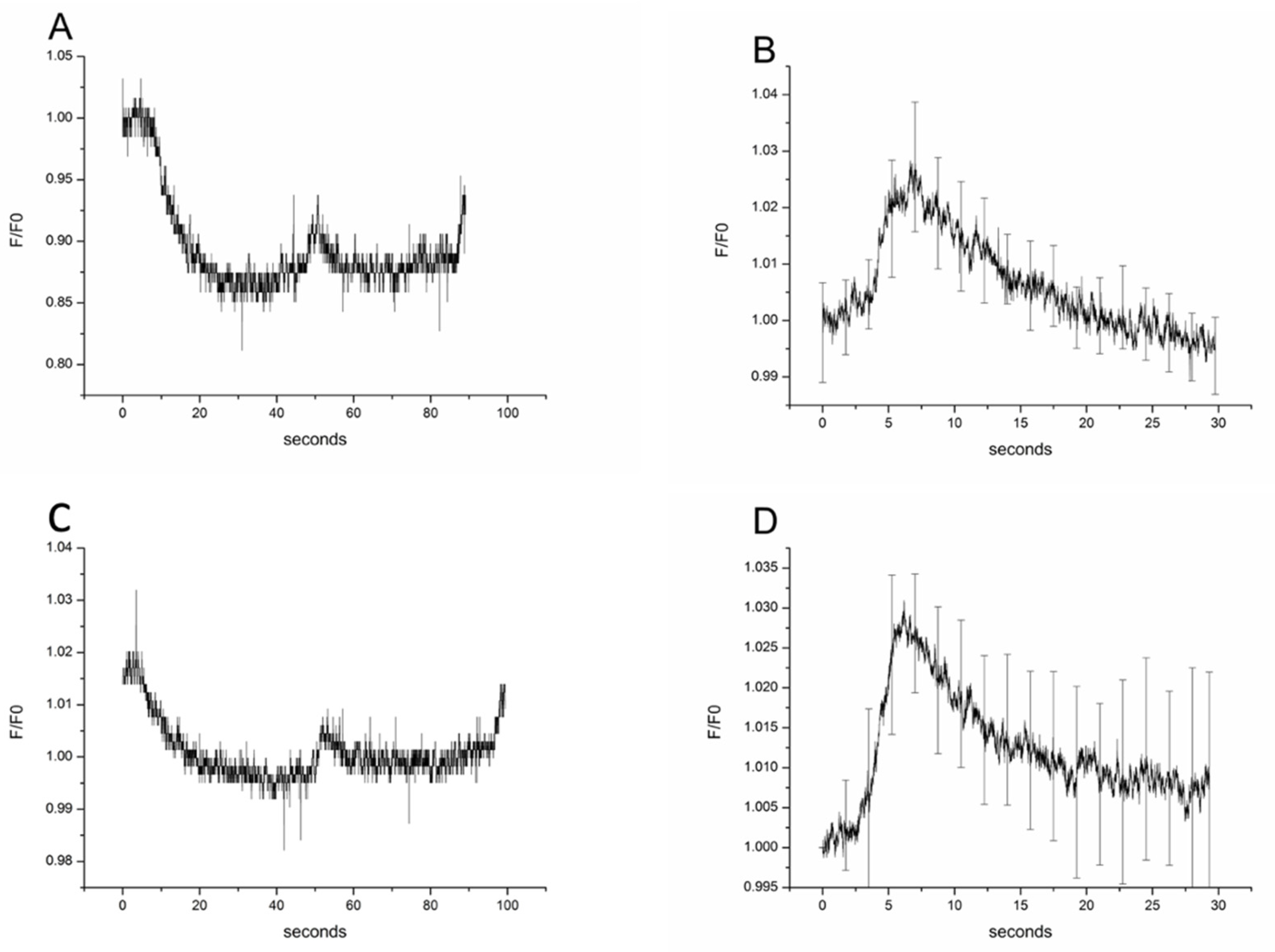Comparison of Isotonic Activation of Cell Volume Regulation in Rat Peritoneal Mesothelial Cells and in Kidney Outer Medullary Collecting Duct Principal Cells
Abstract
1. Introduction
2. Materials and Methods
2.1. Animals
2.2. Cell Culture
2.3. Renal Outer Medullary Collecting Duct Suspension Preparation
2.4. Isolation of Peritoneal Mesothelial Cells
2.5. Experimental Conditions Rationale
2.6. Water Permeability Measurements
2.7. Measurement of the Effect of Urea and Myo-Inositol on Cell Volume
2.8. Measurement of the Intracellular Calcium
2.9. Statistical Analyses
3. Results
3.1. Experiments of Rat OMCD Principal Cells on Isotonic Myo-Inositol and Urea Switch in Hypertonic Environment
3.2. Experiments of Rat Parietal Peritoneum Mesothelial Cells on Isotonic Myo-Inositol and Urea Switch in Hypertonic Environment
3.3. Comparison of RVD Kinetics of Myo-Inositol between Rat Primary OMCD Principal and Parietal Peritoneal Mesothelial Cells
3.4. Comparison of RVD Kinetics Relative to Intracellular Calcium between Rat Primary OMCD Principal and Parietal Peritoneal Mesothelial Cells
4. Discussion
5. Conclusions
Author Contributions
Funding
Institutional Review Board Statement
Informed Consent Statement
Data Availability Statement
Conflicts of Interest
References
- Kempson, S.A. Differential activation of system A and betaine/GABA transport in MDCK cell membranes by hypertonic stress. Biochim. Biophys. Acta-Biomembr. 1998, 1372, 117–123. [Google Scholar] [CrossRef][Green Version]
- Strange, K. Cellular volume homeostasis. Adv. Physiol. Educ. 2004, 28, 155–159. [Google Scholar] [CrossRef]
- Burg, M.B.; Ferraris, J.D.; Dmitrieva, N.I. Cellular response to hyperosmotic stresses. Physiol. Rev. 2007, 87, 1441–1474. [Google Scholar] [CrossRef]
- Hoffmann, E.K.; Lambert, I.H.; Pedersen, S.F. Physiology of cell volume regulation in vertebrates. Physiol. Rev. 2009, 89, 193–277. [Google Scholar] [CrossRef] [PubMed]
- Jentsch, T.J. VRACs and other ion channels and transporters in the regulation of cell volume and beyond. Nat. Rev. Mol. Cell Biol. 2016, 17, 293–307. [Google Scholar] [CrossRef] [PubMed]
- Lindinger, M.I.; Leung, M.J.; Hawke, T.J. Inward Flux of Lactate- through Monocarboxylate Transporters Contributes to Regulatory Volume Increase in Mouse Muscle Fibres. PLoS ONE 2013, 8, e84451. [Google Scholar] [CrossRef]
- Katkova, L.E.; Baturina, G.S.; Ilyaskin, A.V.; Zarogiannis, S.G.; Solenov, E.I. The Water Permeability Reduction After Successive Hypo-Osmotic Shocks in Kidney Principal Cells is Apically Regulated. Cell. Physiol. Biochem. 2014, 34, 1802–1811. [Google Scholar] [CrossRef] [PubMed]
- Solenov, E.I.; Nesterov, V.V.; Baturina, G.S.; Khodus, G.R.; Ivanova, L.N. Effect of dDAVP on basolateral cell surface water permeability in the outer medullary collecting duct. Eur. Biophys. J. 2003, 32, 614–619. [Google Scholar] [CrossRef]
- Baturina, G.S.; Katkova, L.E.; Zarogiannis, S.G.; Solenov, E.I. Brattleboro rats have impaired apical membrane water permeability regulation in the outer medullary collecting duct principal cells. Clin. Exp. Pharmacol. Physiol. 2016, 4, 1225–1233. [Google Scholar] [CrossRef]
- Zarogiannis, S.G.; Ilyaskin, A.V.; Baturina, G.S.; Katkova, L.E.; Medvedev, D.A.; Karpov, D.I.; Ershov, A.P.; Solenov, E.I. Regulatory volume decrease of rat kidney principal cells after successive hypo-osmotic shocks. Math. Biosci. 2013, 244, 176–187. [Google Scholar] [CrossRef]
- De Smet, P.; Simaels, J.; Declercq, P.E.; Van Driessche, W. Regulatory volume decrease in cultured kidney cells (A6): Role of amino acids. J. Gen. Physiol. 1995, 106, 525–542. [Google Scholar] [CrossRef] [PubMed]
- Edwards, A.; Layton, A.T. Cell Volume Regulation in the Proximal Tubule of Rat Kidney: Proximal Tubule Cell Volume Regulation. Bull. Math. Biol. 2017, 79, 2512–2533. [Google Scholar] [CrossRef]
- Katkova, L.E.; Baturina, G.S.; Bondar, A.A.; Jagirdar, R.M.; Hatzoglou, C.; Gourgoulianis, K.I.; Solenov, E.I.; Zarogiannis, S.G. Benign pleural mesothelial cells have higher osmotic water permeability than malignant pleural mesothelioma cells and differentially respond to hyperosmolality. Cell. Physiol. Biochem. 2019, 52, 869–878. [Google Scholar] [PubMed]
- Peppa, V.G.; Solenov, E.I.; Kalomenidis, I.; Tsilioni, I.; Gourgoulianis, K.I.; Hatzoglou, C.; Zarogiannis, S.G. Pleural effusion osmolality correlation with pH and glucose level of pleural fluid and its effects on the pleural membrane permeability. Respir. Physiol. Neurobiol. 2021, 285, 103581. [Google Scholar] [CrossRef]
- Bartosova, M.; Schmitt, C.P. Biocompatible peritoneal dialysis: The target is still way off. Front. Physiol. 2018, 9, 1853. [Google Scholar] [CrossRef] [PubMed]
- Schmitt, C.P.; Bakkaloglu, S.A.; Klaus, G.; Schröder, C.; Fischbach, M. Solutions for peritoneal dialysis in children: Recommendations by the European Pediatric Dialysis Working Group. Pediatr. Nephrol. 2011, 26, 1137–1147. [Google Scholar] [CrossRef]
- Schaefer, B.; Bartosova, M.; Macher-Goeppinger, S.; Ujszaszi, A.; Wallwiener, M.; Nyarangi-Dix, J.; Sallay, P.; Burkhardt, D.; Querfeld, U.; Pfeifle, V.; et al. Quantitative Histomorphometry of the Healthy Peritoneum. Nat. Publ. Gr. 2016, 6, 21344. [Google Scholar] [CrossRef]
- Schmitt, C.P.; Nau, B.; Gemulla, G.; Bonzel, K.E.; Hölttä, T.; Testa, S.; Fischbach, M.; John, U.; Kemper, M.J.; Sander, A.; et al. Article Effect of the Dialysis Fluid Buffer on Peritoneal Membrane Function in Children. Clin. J. Am. Soc. Nephrol. 2013, 8, 108–115. [Google Scholar] [CrossRef]
- Schaefer, B.; Bartosova, M.; Macher-Goeppinger, S.; Sallay, P.; Vörös, P.; Ranchin, B.; Vondrak, K.; Ariceta, G.; Zaloszyc, A.; Bayazit, A.K.; et al. Neutral pH and low–glucose degradation product dialysis fluids induce major early alterations of the peritoneal membrane in children on peritoneal dialysis. Kidney Int. 2018, 94, 419–429. [Google Scholar] [CrossRef]
- Nikitidou, O.; Peppa, V.I.; Leivaditis, K.; Eleftheriadis, T.; Zarogiannis, S.G.; Liakopoulos, V. Animal models in peritoneal dialysis. Front. Physiol. 2015, 6, 261813. [Google Scholar] [CrossRef][Green Version]
- Solenov, E.; Watanabe, H.; Manley, G.T.; Verkman, A.S. Sevenfold-reduced osmotic water permeability in primary astrocyte cultures from AQP-4-deficient mice, measured by a fluorescence quenching method. Am. J. Physiol. Cell Physiol. 2004, 286, C426–C432. [Google Scholar] [CrossRef] [PubMed]
- Ilyaskin, A.V.; Karpov, D.I.; Medvedev, D.A.; Ershov, A.P.; Baturina, G.S.; Katkova, L.E.; Solenov, E.I. Quantitative estimation of transmembrane ion transport in rat renal collecting duct principal cells. Gen. Physiol. Biophys. 2014, 33, 13–28. [Google Scholar] [CrossRef]
- Solenov, E.I.; Baturina, G.S.; Katkova, L.E.; Zarogiannis, S.G. Methods to measure water permeability. Adv. Exp. Med. Biol. 2017, 969, 263–276. [Google Scholar]
- Wilson, C.S.; Mongin, A.A. Cell Volume Control in Healthy Brain and Neuropathologies; Elsevier Ltd.: Amsterdam, The Netherlands, 2018; Volume 81, ISBN 9780128154564. [Google Scholar]
- Pedersen, S.F.; Klausen, T.K.; Nilius, B. The identification of a volume-regulated anion channel: An amazing Odyssey. Acta Physiol. 2015, 213, 868–881. [Google Scholar] [CrossRef]
- Dantzler, W.H.; Layton, A.T.; Layton, H.E.; Pannabecker, T.L. Urine-concentrating mechanism in the inner medulla: Function of the thin limbs of the loops of henle. Clin. J. Am. Soc. Nephrol. 2014, 9, 1781–1789. [Google Scholar] [CrossRef]
- Mount, D.B. Thick ascending limb of the loop of henle. Clin. J. Am. Soc. Nephrol. 2014, 9, 1974–1986. [Google Scholar] [CrossRef] [PubMed]
- Rahman, S.; Park, J.; Kim, J. Osmolytes offset the urea’s effect on protein structure and function. In Cellular Osmolytes: From Chaperoning Protein Folding to Clinical Perspectives; Springer: Singapore, 2017; pp. 77–96. ISBN 9789811037078. [Google Scholar]
- Kuwahara, M. Role of [Ca2+]i and F-actin on mesothelial barrier function. Front. Physiol. 2014, 5, 232. [Google Scholar] [CrossRef] [PubMed]
- Matsuoka, Y.; Yamauchi, A.; Nakanishi, T.; Sugiura, T.; Kitamura, H.; Horio, M.; Takamitsu, Y.; Ando, A.; Imai, E.; Hori, M. Response to hypertonicity in mesothelial cells: Role of Na+/myo-inositol co-transporter. Nephrol. Dial. Transplant. 1999, 14, 1217–1223. [Google Scholar] [CrossRef][Green Version]




Publisher’s Note: MDPI stays neutral with regard to jurisdictional claims in published maps and institutional affiliations. |
© 2021 by the authors. Licensee MDPI, Basel, Switzerland. This article is an open access article distributed under the terms and conditions of the Creative Commons Attribution (CC BY) license (https://creativecommons.org/licenses/by/4.0/).
Share and Cite
Baturina, G.S.; Katkova, L.E.; Schmitt, C.P.; Solenov, E.I.; Zarogiannis, S.G. Comparison of Isotonic Activation of Cell Volume Regulation in Rat Peritoneal Mesothelial Cells and in Kidney Outer Medullary Collecting Duct Principal Cells. Biomolecules 2021, 11, 1452. https://doi.org/10.3390/biom11101452
Baturina GS, Katkova LE, Schmitt CP, Solenov EI, Zarogiannis SG. Comparison of Isotonic Activation of Cell Volume Regulation in Rat Peritoneal Mesothelial Cells and in Kidney Outer Medullary Collecting Duct Principal Cells. Biomolecules. 2021; 11(10):1452. https://doi.org/10.3390/biom11101452
Chicago/Turabian StyleBaturina, Galina S., Liubov E. Katkova, Claus Peter Schmitt, Evgeniy I. Solenov, and Sotirios G. Zarogiannis. 2021. "Comparison of Isotonic Activation of Cell Volume Regulation in Rat Peritoneal Mesothelial Cells and in Kidney Outer Medullary Collecting Duct Principal Cells" Biomolecules 11, no. 10: 1452. https://doi.org/10.3390/biom11101452
APA StyleBaturina, G. S., Katkova, L. E., Schmitt, C. P., Solenov, E. I., & Zarogiannis, S. G. (2021). Comparison of Isotonic Activation of Cell Volume Regulation in Rat Peritoneal Mesothelial Cells and in Kidney Outer Medullary Collecting Duct Principal Cells. Biomolecules, 11(10), 1452. https://doi.org/10.3390/biom11101452






